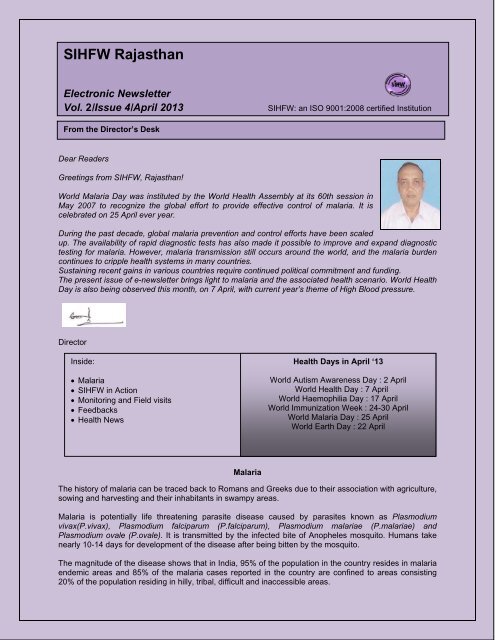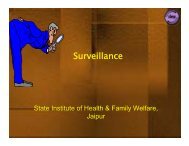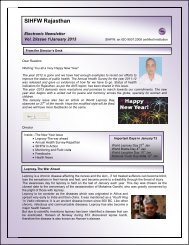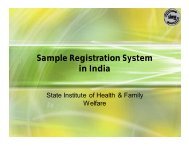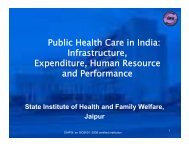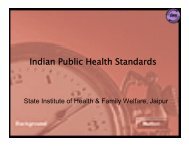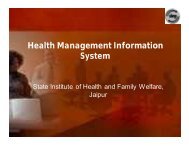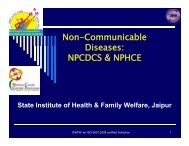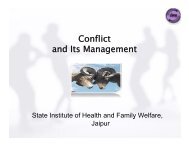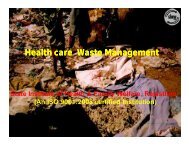E-News Letter Volume Second , Issue Fourth ... - SIHFW Rajasthan
E-News Letter Volume Second , Issue Fourth ... - SIHFW Rajasthan
E-News Letter Volume Second , Issue Fourth ... - SIHFW Rajasthan
- No tags were found...
Create successful ePaper yourself
Turn your PDF publications into a flip-book with our unique Google optimized e-Paper software.
<strong>SIHFW</strong> <strong>Rajasthan</strong><br />
Electronic <strong>News</strong>letter<br />
Vol. 2/ /<strong>Issue</strong> 4/April 2013<br />
<strong>SIHFW</strong>: an ISO 9001:2008 certified Institution<br />
From the Director’s Desk<br />
Dear Readers<br />
Greetings<br />
from <strong>SIHFW</strong>, <strong>Rajasthan</strong>!<br />
World Malaria Day was instituted by the World Health Assembly at its 60th session in<br />
May 2007<br />
to recognize the globall effort to provide effective control of malaria. It is<br />
celebrated<br />
on 25 April ever year.<br />
During the<br />
past decade, global malaria prevention and control efforts have<br />
been scaled<br />
up. The availability of rapid diagnostic tests has<br />
also made it<br />
possible to improve and expand diagnostic<br />
testing for<br />
malaria. However, malaria transmission still occurs around the<br />
world, and the malaria burden<br />
continues<br />
to cripple health systems in many countries.<br />
Sustaining<br />
recent gains<br />
in various countries require continued<br />
political commitment and<br />
funding.<br />
The present issue of e-newsletter brings light to malaria and the associated health scenario. World Health<br />
Day is also being observed this month, on 7 April, with current year’s theme of High Blood pressure.<br />
Director<br />
Inside:<br />
• Malaria<br />
• <strong>SIHFW</strong> in Action<br />
• Monitoring and Field visits<br />
• Feedbacks<br />
• Health <strong>News</strong><br />
Health Days in April ‘13<br />
World Autism Awareness Day : 2 April<br />
World Health Day : 7 April<br />
World Haemophilia Day : 17 April<br />
World Immunization Week : 24-30 April<br />
World Malaria Day : 25 April<br />
World Earth Day : 22 April<br />
Malaria<br />
The history of malaria can be traced<br />
back to Romans and Greeks due to their association with agriculture,<br />
sowing and harvesting and their inhabitants in swampy areas.<br />
Malaria is<br />
potentially life threatening parasite disease caused by parasites known as Plasmodium<br />
vivax(P.vivax),<br />
Plasmodium<br />
falciparum<br />
(P.falciparum),<br />
Plasmodium malariae (P.malariae) and<br />
Plasmodium ovale (P. ovale). It is transmitted by<br />
the infected<br />
bite of Anopheles mosquito. Humans<br />
take<br />
nearly 10-14 days for development<br />
of the disease after being bitten by the mosquito.<br />
The magnitude of the disease shows that in India, 95% of the<br />
population in the country<br />
resides in malaria<br />
endemic areas and 85% of the malaria cases reported in the country are confined to<br />
areas consisting<br />
20% of the population residing in hilly, tribal, difficult and inaccessible areas.
Facts about Malaria<br />
• Pregnant Women are particularly at high risk<br />
of dying due<br />
to malaria- the reason stated high anemia<br />
and spontaneous abortion that is responsiblee for low birth weight babies.<br />
• Half of the world’s population is at risk of malaria- people living in poorest of the countries are highly<br />
vulnerable<br />
• Every<br />
minute a child dies out of<br />
malaria, most of which are under five years of age<br />
• Increase in prevention strategies is now contributing to reduction in malarial mortality.<br />
(source: WHO/Malaria Report/2011)<br />
Disease Spread<br />
• Female Anopheles<br />
mosquito spreads the infection very fast<br />
and discreetly. All of the important vector<br />
species bite at<br />
night.<br />
• Anopheles mosquitoes breed in<br />
water and each species has<br />
its own breeding<br />
preference; for example some prefer<br />
shallow collections of fresh water, such as puddles, rice<br />
fields,<br />
and hoof prints.<br />
• Transmission is more intense in places where the mosquito<br />
lifespan is longer (so that the parasite has time to complete<br />
its development inside the mosquito) and where it prefers to<br />
bite humans ratherr than other animals.<br />
• Transmission also<br />
depends on<br />
climatic conditions that may<br />
affect<br />
the number and survival of mosquitoes, such as rainfall<br />
patterns, temperature and humidity. In<br />
many places,<br />
transmission is seasonal, with the peak during and just after<br />
the rainy season.<br />
Symptoms<br />
Malaria is<br />
an acute febrile illness. In a non-immune individual,<br />
symptomss appear seven days or more (usually 10–15 days) after<br />
the infective mosquito bite.<br />
The first symptoms – fever, headache, chills and<br />
vomiting – may<br />
be mild and difficult to recognize as<br />
malaria. If not treated within<br />
24 hours,<br />
P. falciparum<br />
malaria can progress to severe illness<br />
often leading to death.<br />
Children with severe malaria frequently develop<br />
one or more<br />
of<br />
the following symptoms: severe anaemia, respiratory distress in<br />
relation to<br />
metabolic acidosis, or cerebral malaria. In adults,<br />
multi-organ involvement is also frequent. In malaria endemic<br />
areas,<br />
persons may<br />
develop partial immunity,<br />
allowing<br />
asymptomatic infections to occur.<br />
For both P. vivax and P. ovale, clinical relapses may occur weeks to months after the first infection, even<br />
if the patient has left the malarious<br />
area. Thesee new episodes arise from<br />
dormant liver forms known as<br />
hypnozoites (absent in<br />
P. falciparum<br />
and P. malariae); special treatment – targeted at these liver stages –<br />
is required<br />
for a complete cure.<br />
Vectors of Malaria<br />
There are<br />
9 vectors of Malaria which are prominent in different regions of the country. They are as<br />
follows:<br />
1. Anopheles Culicifacies – Throughout India<br />
2. Anopheles fluviatilis – Through out in foot hills<br />
3. Anopheles minimus – North<br />
Eastern States.<br />
4. Anopheles philipinensis- W. Bengal, North Eastern States and Andaman and Nicobar Islands
5. Anopheles Dirus – Forest Areas of NE States.<br />
6. Anopheles Stephensi - Throughout India.<br />
7. Anopheles Annularis - Throughout India.<br />
8. Anopheles Varuna - Throughout India.<br />
9. Anopheles Saundicus – Coastal Areas of West Bengal and Orissa<br />
The prominent vectors in <strong>Rajasthan</strong><br />
are:<br />
1. Anopheles Culicifacies - In rural areas throughout <strong>Rajasthan</strong><br />
2. Anopheles Stephensi - In urban areas throughout <strong>Rajasthan</strong><br />
3. Anopheles fluviatilis – In foot hills of Alwar and Banswara<br />
Scenario (India and <strong>Rajasthan</strong>)<br />
Malaria is<br />
one of the most wide spread especially<br />
among the South East Asia network of countries<br />
including India. In India, deaths due to malaria<br />
decreasedd from 2006 but again showed an<br />
increase in the year 2009. After 2009, a decrease<br />
was again<br />
reported till the year 2011. (Graph Source:<br />
nvbdcp/mohfw/report)<br />
The table<br />
below shows the number of cases and<br />
deaths reported due to malaria in<br />
last 10 years<br />
(from 2001-2011). Maximum number of malarial<br />
deaths was reported in<br />
the year 2007. However, by 2011, we<br />
could reduce the deaths<br />
due to Malaria by<br />
nearly half of the number cases as compared to 2007 (753).<br />
In <strong>Rajasthan</strong>,<br />
out of 33<br />
districts, 20 districts are more<br />
prone to<br />
malaria. These<br />
districts are Alwar, Ajmer<br />
Barmer, Banswara Bharatpur,<br />
Bhilwara, Bikaner, Bundi<br />
Churu,<br />
Dholpur, Dungarpur,<br />
Jaisalmer, Jodhpur, Nagaur,<br />
Pratapgarh Rajsamand, Sirohi,<br />
Sawai Madopur, Sri<br />
Ganganagar and Udaipur. The<br />
table represents the number of<br />
cases reported and the<br />
trend<br />
of deaths from 2009 to<br />
2012 in<br />
<strong>Rajasthan</strong>.<br />
Trend in India<br />
Cases (in<br />
Year Million)<br />
Deaths<br />
API<br />
Total Pf<br />
2001 2002 2003 2004 2005 2006 2007 2008 2009 2010 2011<br />
2.09<br />
1.84<br />
1.87<br />
1.92<br />
1.82<br />
1.79<br />
1.51<br />
1.53<br />
1.56<br />
1.49<br />
1.31<br />
1.01<br />
0.9<br />
0.86<br />
0.89<br />
0.81<br />
0.84<br />
0.74<br />
0.77<br />
0.84<br />
0.77<br />
0.66<br />
1005 973 1006 949 963 1707 1311 1055 1144 767 753 2.06<br />
1.8<br />
1.82<br />
1.84<br />
1.68<br />
1.66<br />
1.39<br />
1.36<br />
1.36<br />
1.3<br />
1.14<br />
source: nvbdcp/mohfw/report/2011<br />
Trend in <strong>Rajasthan</strong><br />
Year<br />
2009<br />
2010<br />
2011<br />
2012<br />
Cases<br />
32709<br />
50945<br />
54294<br />
45809<br />
Pf<br />
1767 2331 2973 1394<br />
Deaths<br />
18<br />
26<br />
45<br />
22<br />
source:nvbdcp/mohfw/<br />
/report/2011<br />
Diagnosis and Treatment<br />
Early diagnosis and treatment of malaria reduces disease and prevents<br />
deaths. It also contributes to<br />
reducing malaria transmission. The best available treatment, particularly for P. falciparum malaria, is<br />
Artemisinin-Based Combination Therapy (ACT).<br />
WHO recommends that all casess of suspected malaria should be confirmed using parasite-based<br />
diagnostic<br />
testing (either microscopy or rapid diagnostic test)<br />
before administering the treatment. Results<br />
of parasitological confirmation are available in 15 minutes or<br />
less. Treatment solely based on symptoms<br />
should only be considered when a parasitological diagnosis is<br />
not possible.
Prevention<br />
Vector control is the main way to reduce malariaa transmissionn at the community level. Vector control<br />
is an<br />
intervention that can reduce malariaa transmission from extremely high levels to extremely low levels. For<br />
individuals, personal protection against mosquito bites represents the first line of defense for malaria<br />
prevention. Two forms of vector control are effective in a wide<br />
range of circumstances.<br />
1. Insecticide-treated<br />
mosquito nets (ITNs): Long-lasting insecticidal nets<br />
(LLINs) are the preferred<br />
form<br />
of ITNs for public health distribution programmes. WHO recommends<br />
coverage for all at-risk persons;<br />
and in<br />
most of the<br />
settings. The most cost effective way<br />
to achieve this is through provision of free<br />
LLINs, so that everyone sleeps under a LLIN<br />
every night.<br />
2. Indoor spraying with residual insecticides: Indoor residual spraying<br />
(IRS) with insecticidess is a<br />
powerful way to rapidly reduce malaria transmission. Its full potential is when at least 80% of houses<br />
in targeted areas are sprayed completely. Indoor spraying is effectivee for 3–6 months, depending on<br />
the insecticide used and the type of surface<br />
on which it<br />
is sprayed. DDT can be effective for 9–12<br />
months in some cases. Longer-lasting forms of existing IRS insecticides, as well as new classes of<br />
insecticides for use<br />
in IRS programmes, are under development.<br />
Clinical Prevention<br />
• Antimalarial medicines can be used to prevent malaria.<br />
• For travelers, malaria<br />
can be prevented<br />
through<br />
chemoprophylaxis,<br />
which suppresses the blood stage of<br />
malaria infections, thereby preventing malaria disease.<br />
• In addition, WHO<br />
recommends intermittent preventive<br />
treatment with Sulfadoxine-pyrimethaminee for pregnant<br />
women living in high transmission areas, at each<br />
scheduled antenatal visit after the first trimester. Similarly,<br />
for infants living in high-transmission areas of Africa, 3<br />
dosess of intermittent preventivee treatment with sulfadoxine-<br />
pyrimethamine<br />
is<br />
recommended<br />
delivered<br />
alongside<br />
routine vaccinations.<br />
General Strategy for Prevention and Control of Vector<br />
Borne Diseases<br />
Some of the control strategies proposed for the<br />
next five-year<br />
plan i.e. 12 Five Year<br />
Plan are:<br />
• Early Diagnosis and Complete Treatment<br />
• Integrated Vector Management<br />
(IRS, LLIN, Fish chemical<br />
and bio- larvicide, source reduction)<br />
• Supportive Intervention<br />
• Behaviour Change<br />
Communication<br />
• Improving Surveillance in high endemic areas<br />
• Strengthening microscopy services at PHCs along with<br />
quality<br />
assurance<br />
both for microscopy<br />
and Rapid<br />
Diagnostic Test (RDT) and complete treatment of malarial<br />
casess and deaths<br />
World Health<br />
Day-7 April<br />
2013<br />
World Health Day is celebrated<br />
on 7 April<br />
every year on anniversary of the<br />
founding of<br />
WHO in 1948. Every year a theme is<br />
selected that highlights a priority area of<br />
public Health concern in the world. The<br />
theme for this year is High Blood Pressure.<br />
High Blood Pressuree is also known as raised<br />
BP of Hypertension-increases<br />
the risk of<br />
heart attacks, strokes and kidney failure. If<br />
left uncontrolled, high blood pressure can<br />
also cause blindness, irregularities of the<br />
heartbeat and heart<br />
failure. Though it affects<br />
more than one in three adults worldwide, it<br />
remains largely hidden. Many people do not<br />
know they have high blood<br />
pressure<br />
because it does<br />
not always<br />
cause<br />
symptoms. As a result, it leads to more than<br />
nine million deaths<br />
every year, including<br />
about half of all deaths due to heart disease<br />
and stroke.<br />
Source: WHO
<strong>SIHFW</strong> in<br />
Action<br />
Trainings/workshopss organized:<br />
Trainings<br />
at <strong>SIHFW</strong><br />
S. No.<br />
1.<br />
2.<br />
3.<br />
4.<br />
5.<br />
6.<br />
7.<br />
8.<br />
9.<br />
10.<br />
Date<br />
Title<br />
Cadre (Total<br />
Participants<br />
18 February-19 March<br />
2013<br />
4-8 and 11‐15 March<br />
2013<br />
8-9 March 2013<br />
Integrated Foundation for Newly<br />
Recruited Medical Officer<br />
Training on Malaria for Medical<br />
Officers at <strong>SIHFW</strong><br />
CBI-RI Monthly Report<br />
29 (MOs)<br />
46 (MOs)<br />
12 (Divisional RI<br />
Coordinators and<br />
External Monitors)<br />
5-7 Mar, 12-14, 19-21<br />
Mar 2013<br />
11-13 March<br />
2013<br />
Routine Immunization at <strong>SIHFW</strong><br />
Capacity Building on IEC<br />
BCC 51 (MOs)<br />
38 (District IEC<br />
Officials)<br />
18-20 March<br />
2013 Training on Dengue for Medical<br />
Officers at <strong>SIHFW</strong><br />
28 (MOs)<br />
20 March 2013<br />
PCPNDT Workshop<br />
105<br />
( MN/SDO/Radiologist)<br />
22 March 2013<br />
Workshop on District Level PCPNDT<br />
66 (Coordinators )<br />
24 March 2013<br />
Workshop on TB for Ayush Doctors<br />
60 (Ayush MOs)<br />
23 March 2013<br />
Consultationn workshop on<br />
80 (NGO<br />
Maternal Health Security<br />
representatives)<br />
Integrated Training for In-Servicee Medical Officers<br />
Sponsoring<br />
Agency<br />
NRHM<br />
RCH<br />
UNICEF<br />
DM&HS<br />
DM&HS<br />
DM&HS<br />
PCPNDT Cell<br />
PCPNDT Cell<br />
DM&HS<br />
PRAYAS<br />
11.<br />
6 March -6 April 2013<br />
Integrated training of In-service<br />
MOs at Government Medical<br />
College, Kota<br />
10 (MOs)<br />
RCH<br />
12.<br />
12 March -12<br />
April 2013<br />
Integrated training of In-service<br />
MOs at RNT<br />
Medical College,<br />
Udaipur<br />
8 (MOs)<br />
RCH<br />
13.<br />
19-23 March<br />
2013<br />
ToT on FIMNCI at JK Loan 7 (Pediatricians)<br />
Hospital, Jaipur<br />
RCH<br />
Integrated Training with SBA (Plan-4)<br />
14. 1-30 March 2013<br />
Rajsamand<br />
16 (Health workers)<br />
RCH<br />
15.<br />
1-30 March 2013<br />
Pratapgarh<br />
16 (Health workers)<br />
RCH<br />
16.<br />
1-30 March 2013<br />
Sikar<br />
15 (Health workers)<br />
RCH<br />
17.<br />
4 March - 4 April 2013<br />
Bikaner<br />
16 (Health workers)<br />
RCH<br />
18.<br />
12 March - 17 April<br />
2013<br />
Ajmer<br />
16(Health workers)<br />
RCH
Integrated Training with-out SBA<br />
S. No. Date<br />
19.<br />
1-15 March 2013<br />
(Plan-5)<br />
Title<br />
Tonk<br />
Cadre (Total<br />
Participants<br />
24 (Health workers)<br />
Sponsoring<br />
Agency<br />
RCH<br />
20.<br />
1-15 March 2013<br />
Jaipur<br />
30 (Health workers)<br />
RCH<br />
21.<br />
2-16 March 2013<br />
Banswara<br />
30 (Health workers)<br />
RCH<br />
22.<br />
5-19 March 2013<br />
Sirohi<br />
30 (Health workers)<br />
RCH<br />
23.<br />
4-18 March 2013<br />
Dausa<br />
30 (Health workers)<br />
RCH<br />
24.<br />
7-21 March 2013<br />
Pali<br />
26 (Health workers)<br />
RCH<br />
25.<br />
11-25 March<br />
2013<br />
Rajsamand<br />
30 (Health workers)<br />
RCH<br />
26.<br />
11-25 March<br />
2013<br />
Nagaur<br />
28 (Health workers)<br />
RCH<br />
27.<br />
15-31 March<br />
2013<br />
Kota<br />
30 (Health workers)<br />
RCH<br />
28.<br />
8-22 March 2013<br />
Ajmer<br />
30 (Health workers)<br />
RCH<br />
29.<br />
11-23 March<br />
2013<br />
Baran<br />
24 (Health workers)<br />
RCH<br />
30.<br />
15-31 March<br />
2013<br />
Chittorgarh<br />
30 (Health workers)<br />
RCH<br />
31.<br />
29 March-29<br />
April 2013<br />
Jaisalmer<br />
30 (Health workers)<br />
RCH<br />
RI at Districts<br />
32.<br />
1-2 and 5-6 March 2013<br />
RI for Health workers at<br />
Rajsamand<br />
30, 30 (Health<br />
workers)<br />
RCH<br />
33.<br />
2-3, 11-12, 24-25 and<br />
29-30 March<br />
2013<br />
Jhunjhunnuu<br />
21,19, 22, 22 (Health<br />
workers)<br />
RCH<br />
34.<br />
5-6 March 2013<br />
20 (Health workers)<br />
RCH<br />
35.<br />
7-8 March 2013<br />
Jalore<br />
24 (Health workers)<br />
RCH<br />
36.<br />
8-9 March 2013<br />
Sikar<br />
25 (Health workers)<br />
RCH<br />
37.<br />
15-16 March<br />
2013<br />
Ganganagar<br />
23 (Health workers)<br />
RCH<br />
38.<br />
18-19 and 20-21 March<br />
2013<br />
Hanumangarh<br />
30, 30 (Health<br />
workers)<br />
RCH<br />
39.<br />
21-22 March<br />
2013<br />
Dausa<br />
30 (Health workers)<br />
RCH<br />
40.<br />
5-8, 12-15, and 19-22<br />
March 2013<br />
FBNC training at JLN Medical<br />
College and<br />
Hospital, Ajmer<br />
11,13,11 (MOs and<br />
Health workers)<br />
RCH<br />
Training for Blood Storage Unit<br />
41.<br />
2-6, 07-12, 14-18 and<br />
20-24 March<br />
2013<br />
Training for<br />
Dausa<br />
Blood Storage Unit at 4 (Lab Technicians)<br />
RCH<br />
42.<br />
11-15, 16-20, 21-25<br />
and March 2013<br />
Training for<br />
Bundi<br />
Blood Storage Unit at 4,4,4 (Lab<br />
Technicians)<br />
RCH<br />
43.<br />
20-21 March<br />
2013<br />
Training for<br />
Pali<br />
Blood Storage Unit at 6 (Lab Technicians)<br />
RCH<br />
44.<br />
29 March-2 April 2013<br />
Training for<br />
Jaisalmer<br />
Blood Storage Unit at 4 (Lab Technicians)<br />
RCH
Monitoring/Field Visits<br />
Monitoring of Integrated Training<br />
Training<br />
In servicee Medical Officers<br />
Integrated Foundationn<br />
FBNC Training<br />
Integrated Foundationn<br />
Integrated Foundationn<br />
RI at Districts<br />
Monitor<br />
Dr<br />
Bhumika<br />
Mr. Anil Sharma<br />
Mr. Mohit Dhonkeriya<br />
Ms. Indu<br />
District<br />
Udaipur<br />
Jodhpur<br />
Bikaner<br />
Hanumangarh<br />
Date<br />
18-19 March<br />
2013<br />
18-19 March<br />
2013<br />
18-19 March<br />
2013<br />
19-20 March<br />
2013<br />
Co-ordination Visit for Integrated Training<br />
Agenda<br />
Implementation of<br />
Integrated Training<br />
Representative<br />
Mr. Ravi Garg<br />
Dr Bhumika Talwar<br />
Ms Aditi Sharma<br />
Ms. Poonam<br />
and<br />
Ms. Nishanka Chauhan<br />
District<br />
Bundi<br />
Kota<br />
Baran<br />
Sikar,<br />
Sriganganagar,<br />
Churu,<br />
Date<br />
28 Feb-1 March 2013<br />
4-7 March 2013<br />
Hanumangarh<br />
Visitors<br />
PDC Indore Team<br />
A team of PDC participants from Indore (Madhya Pradesh)<br />
visited <strong>SIHFW</strong> during 18-21 March<br />
2013. The team visited<br />
Amer CHC, Jaipuriyaa Hospital, Disha NGO, Jaipur and<br />
HFWTC Ajmer and Bhagwan Mahaveer Viklang Sahayta<br />
Samiti.<br />
Dr Mamta Chauhan, Faculty <strong>SIHFW</strong> made a brief<br />
presentations on ‘Leadership and Communication skills’ and<br />
‘<strong>Rajasthan</strong> at a Glance’.
Celebration<br />
Birthday of Dr Bhumika<br />
Talwar was celebrated on 24<br />
March 2013 at <strong>SIHFW</strong>.<br />
The Forthcoming<br />
1. Training for Routine Immunization at<br />
<strong>SIHFW</strong>, 2-4 April 2013<br />
2. PDC VII Batch starting from 25 April 2013.<br />
3. EmOC training starting from 30 March-2 August 2013.<br />
Feedback<br />
1.<br />
2.<br />
3.<br />
4.<br />
5.<br />
Almost all participants (94%) rated the quality of training as Excellent (RI for MOs at <strong>SIHFW</strong>,<br />
19-21 March<br />
2013).<br />
Training was<br />
rated ‘Good’ by majority (74%)of the participants (Training on Dengue for MOs 17-<br />
20 March 2013)<br />
Detailed information on each and every important aspect of RI was given.<br />
Hostel facility<br />
was most liked and rooms were clean<br />
and good management, with silent<br />
environment,<br />
‘Room tea arrangement and snacks’ was liked the most and overall experience of stay at<br />
<strong>SIHFW</strong> was excellent- By<br />
Dr. Srikant Basu, MD Pediatrician, Kalawati Saran, New Delhi<br />
Health <strong>News</strong><br />
Global<br />
Battle Against US Childhood Obesity Sees Success<br />
U.S. groups and companies that have tried to change the country's growing childhood obesity rate are<br />
starting to<br />
see noteworthy outcomes as more American children exercise and have<br />
better access to<br />
healthy foods, a new<br />
study reports. Exercise has been<br />
widely publicised, and has successfully<br />
encouraged 3 million children to start becoming more physically active over the last year.<br />
The current report was released by<br />
The Partnership for a Healthier America (PHA) in accordance<br />
with<br />
First Lady<br />
Michelle Obama. It is the first progress update<br />
on the private sector's solutions to solve<br />
childhood obesity throughout the U.S. The findings were released as PHA starts its second "Building a<br />
Healthier Future Summit" in Washington D.C., where experts from the private and public sectors united to<br />
pinpoint solutions to the childhood obesity epidemic that has become a major public health issue the U.S.<br />
In 2010, President Obama issued a task force to<br />
address the nation's growing childhood obesity problem.<br />
It came about as a part of Michellee Obama's "Let's Move" campaign, in an effort to combine the work of
the public<br />
and private sectors to help children become more<br />
active in their everyday lives and adopt a<br />
healthier diet.<br />
HA CEO Lawrence A. Soler explains:"Our partner organizations are making changes to their operations<br />
and their business practices that help make healthier choices easier for busy parents and families. This<br />
report is about holding<br />
a mirror up to efforts against those commitments - many of which are multi-year -<br />
and givingg the public a clear understanding of their progress."<br />
Although the effort has<br />
achieved a great deal, some health advocates are saying that even more of an<br />
effort is needed, including government input. Currently in the U.S., one in three children is obesee and<br />
another third are considered overweight. Health professionals are concerned because overweight<br />
children have a higher<br />
risk of being<br />
overweight as adults and<br />
may develop heart disease, diabetes, and<br />
other health issues.<br />
Health experts have been critical of<br />
certain food companies for selling unhealthy products. Manufacturers<br />
have always cited consumer choice, but many<br />
have started to change<br />
their products recently as a<br />
growing number of U.S. consumers become more health conscious.<br />
Soler concluded:"We<br />
know the private sector alone cannot solve this crisis - it will take work<br />
from<br />
everyone,<br />
including communities, schools, non-profits, governments, families and more. PHA commends<br />
our partners for the remarkable goals they have<br />
set to help make it easier for kids and families to make<br />
the healthy choice."<br />
Source: www/NIHFW/Health <strong>News</strong>/ /Medical <strong>News</strong> Today, 9.3. 13<br />
Exercise Prevents Children from Getting Stressed<br />
New research published in The Endocrine Society's Journal of Clinical Endocrinology & Metabolism<br />
(JCEM) reveals that exercise could be key to helping children cope with stress.<br />
The study<br />
identified that sedentary children exposed to stressful events produced more of the hormone<br />
called cortisol, which is linked to stress, than kids who weree very active. The cardiovascular benefits of<br />
exercise in children is already very<br />
well established, but it also has a significant impact on their mental<br />
health too. One study found that regular exercisee can help children do better in math.<br />
The study<br />
is the first of its kind to link physical activity in<br />
children with stress hormone responses.<br />
According<br />
to the lead author of the study, Silia<br />
Martikinen, of the University of Helsinki: "The findings<br />
suggest physical activity plays a role in mental health by buffering children from the effects of<br />
daily<br />
stressors,<br />
such as public speaking,"<br />
A total of 252 eight year old children participated in the study. The researchers monitored their physical<br />
activity by<br />
making them wear accelerometer<br />
devices and measured cortisol levels<br />
by taking saliva<br />
samples. The children were given tasks involving<br />
mathematics and story-telling.<br />
They separated the children into groups (active, intermediate, or sedentary) based on the amount of<br />
physical activity they did. The active group exercised for longer and more<br />
rigorously than the children in<br />
the others, the researchers found that their cortisol levels didn't increase as<br />
much during<br />
the tasks.<br />
In contrast, the cortisol levels went<br />
up significantly among n those in the<br />
sedentary group. Martikainen<br />
said: "Clearly, there is a link between mental and physical well-being, but the nature of the connection is<br />
not well understood. These resultss suggest exercise promotes mental health by regulating the stress<br />
hormone response to stressors."<br />
Source: www/NIHFW/Health <strong>News</strong>/ /Medical <strong>News</strong> Today, 9.3. 13
India<br />
Digital Database for TB<br />
India has set up a digital database of 1.4 million<br />
people being treated freee for tuberculosis, under the Rs<br />
710 crore revised National TB Control Programme (RNTCP), to ensure better treatmentt and compliance.<br />
‘Nikshay enables near-real time reporting of TB cases and<br />
ensures tracking and case management,<br />
specially in inaccessible areas and places where patients have high mobility’ said Anshu Prakash, Joint<br />
Secretary, Union Ministry of Health and Family Welfare.<br />
In India, TB kills two<br />
persons every three minutes-more<br />
malaria, leprosy and tropical diseases combined.<br />
than AIDS,<br />
sexually-transmitted diseases,<br />
India has 66,000 cases of MDR TB<br />
and 22 of extreme drug-resistant with DNA-based MDR<br />
and XDR testing equipment in<br />
TB. To ensure early diagnosis and<br />
treatment, the government will provide 200 districts<br />
2013-14. Currently, sputum sampless of suspected MDR casess are transferred to a few dozen DNA testing<br />
centers, so results take<br />
four to five days. By the end of the 12<br />
th Five-Year<br />
Plan (2012-17), all districts will<br />
have DNA-based testing facilities.<br />
Diagnosiss and treatment are already provided free to all under RNTCP, which ensuress patients will take<br />
the drug under supervision on alternate days.<br />
TB was made a notifiable disease in May 2012, since then it has been mandatory for all private clinics to<br />
report all cases to the government and follow treatment protocols.<br />
Source: Hindustan Times, 25. 03.2013<br />
India to introduce new<br />
TB drug<br />
With multi-drug resistant (MDR) and extensively drug resistant tuberculosis (XDR TB) threatening the<br />
country, the government is set to introduce a new TB drug, Bedaquiline, on an experimental basis. The<br />
drug will be introducedd in areas which have so<br />
far reported<br />
a large number of MDR<br />
TB and XDR TB<br />
cases.<br />
The government is in the process of identifying these areas. The drug would be administered to patients<br />
found to be resistant to two vital primary drugs<br />
in the DOTS<br />
Plus regimen. As per records, nearly two<br />
million Indians develop<br />
TB each year. Mumbai is<br />
emerging as<br />
ground zero<br />
for MDR TB. Approved by the<br />
US regulator in January this year, Bedaquiline is used for treatment of MDR TB as part of combination<br />
therapy in<br />
adults. According to the Lancet, results from randomised trials<br />
on the efficacy of Bedaquiline<br />
showed significant reduction in the infection period. Approval of the drug was also based on studies that<br />
showed it “killed” bacteria quicker than the existing drug regimen.<br />
Discovered by scientists at Janssen, the pharmaceuticals unit of Johnsonn & Johnson, the FDA approval<br />
for a new TB drug comes after more than 50 years. The Indian Council of<br />
Medical Research and Central<br />
TB Division of DGHS<br />
recently convened an expert group for the introduction of Bendaquiline. “It is<br />
proposed to introduce the drug in India under controlled conditions at 4-5<br />
DOTS Plus sites to assess its<br />
impact on<br />
MDR and XDR TB,” Union health minister Ghulam Nabi Azad said.<br />
Twenty-two countries bear 80 per cent of the burden of TB<br />
worldwide. According to<br />
WHO, there are<br />
around nine million new<br />
cases of TB<br />
detected and close to two million people die of it each year. In India,<br />
TB is rated as a major public health problem and<br />
the country accounts for one-fifth of global TB cases.<br />
Source: The Asian Age: 9.3.2013<br />
Over 56 Percent Young Indian Girls, 30 Percent Indian Boys Anemic<br />
Anemia is<br />
prevalent among Indian youth and over 56 percent of adolescent girls and 30 percent of the<br />
boys in India are anemic, the Indiann parliament was told Tuesday.
More than<br />
39 percent adolescent girls in the age<br />
group of 15-19 years are mildly anemic while 15 percent<br />
and 2 percent suffer from moderate and severee anemia respectively. Health Minister<br />
Gulab Nabi Azad<br />
told Rajyaa Sabha.<br />
Anemia is<br />
a long standing problem<br />
in India and the country has high prevalence of<br />
anemia amongst<br />
adolescents.<br />
As per reports of the national Family Health Survey (2005-06), adolescent girls in particular are<br />
vulnerablee to anemia due to the rapid growth of the body and loss of blood during menstruation.<br />
more<br />
Azad said<br />
to contain the spread of anemia, the ministry of<br />
health and<br />
weekly iron and folic acid supplementation.<br />
family welfare has launched a<br />
The programme is estimated to cover approximately 13 crore<br />
beneficiaries<br />
and will meet the challenge of<br />
anemia amongst adolescent girls and boys in the<br />
age group o 10-19 years.<br />
As of now<br />
the programme has been<br />
rolled out in<br />
18 states and remaining states and Union territories are<br />
at different stages of preparedness<br />
for implementing the programme.<br />
The programme is being implemented in both rural and urban<br />
areas and covers school going adolescent<br />
girls and boys in 6 th to<br />
12 th class enrolled in government or<br />
government<br />
aided schools and anganwadi<br />
centres.<br />
Source: IANS, 13 March 2013<br />
<strong>Rajasthan</strong><br />
Anti-tobacco campaign held<br />
The state’s health department and<br />
tobacco control<br />
cell have organised a 20-day campaign in the city to<br />
help school children understand the ill effects of<br />
consuming tobacco and its derivatives. More than 40<br />
schools have been covered under this campaign<br />
held<br />
as part of the National Tobacco Control Programme.<br />
As part of the campaign, volunteers of a theatre<br />
group, Ras Rang Manch Sanstha, went to<br />
the<br />
schools and conductedd training sessions for students<br />
from classes seven to 12. They answered questions<br />
and delved into reasons and behavioural influences<br />
that lead to tobacco addiction in students. Besides,<br />
they discussed<br />
remedies.<br />
The campaign also<br />
focused on making students aware of the anittobacco<br />
laws existing in the country.<br />
Source: 14 March H.T<br />
We solicit<br />
your feedback:<br />
State Institute of Health<br />
& Family Welfare<br />
Jhalana Institutional Area, South of Doordarshan<br />
Kendra Jaipur (Raj)<br />
Phone-2706496, 2701938, Fax- 2706534<br />
E-mail:-sihfwraj@ymail.com; Website:<br />
www.sihfwrajasthan.com<br />
New Scheme<br />
Motivation<br />
for Giving Birth to Girl Child<br />
With<br />
objective of reducing Female Feticide and<br />
bringing improvement in Sex<br />
ratio of the <strong>Rajasthan</strong>,<br />
Mukhyamantri (CM) Shublakshmi<br />
Scheme<br />
was<br />
launched in State<br />
on 1 st April 2013. The scheme has<br />
a provision of payment of Rs<br />
7300 (in installments)<br />
for a span of five<br />
years after the birth of a girl child.<br />
Hon’ Minister, Shri A. A Khan<br />
distributed cheques of<br />
Rs 2,100/- to women who delivered bay girls at<br />
Mahilla Chikitsalaya at Sanganeri Gate, Jaipur.<br />
The<br />
Medical, health and Family Welfare department<br />
has given its officers the responsibility to ensure that<br />
the new scheme is successfully implemented and<br />
eligible women get its benefit without any difficulty.<br />
There will be a nodal officer<br />
of director rank at the<br />
state<br />
level and at the district level, the RCHO<br />
(Reproductive and Child Health Officer) will be the<br />
nodal officers for the scheme. The In-charge at the<br />
CHCC and PHC will be nodal officer at sector level.<br />
The<br />
scheme’s benefit will be given to the beneficiary<br />
at sub-centre level by auxiliary nurse midwife (ANM).<br />
After completing one year (after the first installment of<br />
Rs 2,100/- at time of birth) the<br />
women will get another<br />
benefit of Rs 2, 100/- after successful completion of<br />
routine immunization programmes of the state<br />
government. The<br />
last benefit under the scheme of Rs<br />
3,100/- will be given after completion of five years of<br />
child’s life. Under Janani Suraksha Yojana, women<br />
are paid Rs 1,400/- (Rural) and Rs 1,000/- (Urban).<br />
After the launch of the new scheme, women will now<br />
receive Rs 8,700/- in rural areas and Rs<br />
8,300/- in<br />
urban areas.<br />
This<br />
scheme will also encourage parents to follow<br />
routine immunization programmes.


